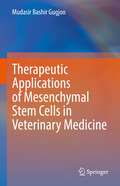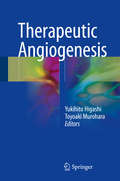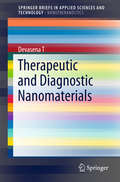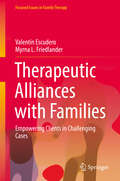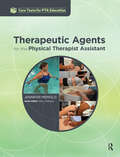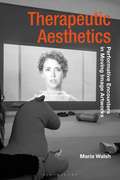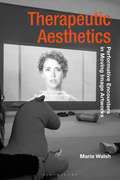- Table View
- List View
Therapeutic Applications of Mesenchymal Stem Cells in Veterinary Medicine
by Mudasir Bashir GugjooThis book reviews the potential therapeutic and reproductive applications of mesenchymal stem cells in veterinary regenerative and reproductive medicine. The systemic approach focuses on musculoskeletal structures like cartilage, bone, muscle, tendon, ligaments and nervous tissues. It also focuses on other body systems like gastrointestinal, cardiovascular, urogenital, respiratory and integumentary system. Besides, the special glands or organs like endocrine glands and eye and its adnexa are also focused. The book chapters discusses the problems and the need for regenerative medicine employing MSCs. It provides an ex vivo basis of MSCs therapeutics and reproductive potential followed by their in vivo applications. The book further provides an understanding on the behavior and mechanisms of action of mesenchymal stem cells. The book also abridges challenges and provides future prospects of mesenchymal stem cells in clinical and reproductive applications. As such, the book offers a valuable resource for students, veterinarians, and scientists working in the regenerative and reproductive sciences in human and veterinary medicine.
Therapeutic Applications of Langerian Mindfulness
by Sayyed Mohsen Fatemi Ph.D.Therapeutic Applications of Langerian Mindfulness Explore an authoritative new treatment of Langerian mindfulness Therapeutic Applications of Langerian Mindfulness delivers a collection of novel psychotherapeutic techniques grounded in Langerian mindfulness for dealing with psychological problems. The author draws on empirically grounded psychological research to demonstrate new approaches to fostering creativity and novelty in the reader or the reader’s patients. The book includes practical exercises that allow the reader to apply the concepts and techniques discussed within to help them manage anxiety, relationships, creativity, and productivity and performance. It also includes: A thorough introduction to Langerian mindfulness and how it differs from meditation-based mindfulness Practical discussions of the relationship between mindfulness, anxiety, and depression, as well as the key strategies for dealing with anxiety and depression with Langerian mindfulness Comprehensive explorations of mindfulness and agency, as well as the relationship between agency and wellness In-depth examinations of the phenomenological configuration of mindfulness, including discussions of the psychology of presence Perfect for mindfulness practitioners and enthusiasts in both lay and professional audiences, Therapeutic Applications of Langerian Mindfulness is an indispensable resource for therapists and practitioners seeking a one-stop reference on Langerian mindfulness. “In Therapeutic Applications of Langerian Mindfulness, Professor Sayyed Mohsen Fatemi provides clear and concrete examples of how Langerian mindfulness both liberates and heals. Basing his reflections on the inspiration of his mentor, Professor Ellen Langer, Fatemi shows in brilliant, methodical chapters the range of ways this mindfulness approach can transform lives. In the end, what both Langer and Fatemi stress is the power of attitude to make remarkable shifts in our capacity for mental and physical wellbeing. Whereas an attitude of mindfulness opens the world to virtually inexhaustible possibilities, an attitude of mindlessness—or what I call the polarized mind—shuts this process down entirely, and is one of the pivotal bases for the decay we see today, both in individuals and the societies that bear them.” — Kirk J. Schneider, PhD, author of The Polarized Mind, The Depolarizing of America, Awakening to Awe, and most recently Life-Enhancing Anxiety: Key to a Sane World “This book provides an in-depth practical analysis of cutting-edge research on Langerian mindfulness and offers promising techniques on healing, wellbeing, and growth.” —Ellen J. Langer, Harvard University
Therapeutic Applications of Langerian Mindfulness
by Sayyed Mohsen Fatemi Ph.D.Therapeutic Applications of Langerian Mindfulness Explore an authoritative new treatment of Langerian mindfulness Therapeutic Applications of Langerian Mindfulness delivers a collection of novel psychotherapeutic techniques grounded in Langerian mindfulness for dealing with psychological problems. The author draws on empirically grounded psychological research to demonstrate new approaches to fostering creativity and novelty in the reader or the reader’s patients. The book includes practical exercises that allow the reader to apply the concepts and techniques discussed within to help them manage anxiety, relationships, creativity, and productivity and performance. It also includes: A thorough introduction to Langerian mindfulness and how it differs from meditation-based mindfulness Practical discussions of the relationship between mindfulness, anxiety, and depression, as well as the key strategies for dealing with anxiety and depression with Langerian mindfulness Comprehensive explorations of mindfulness and agency, as well as the relationship between agency and wellness In-depth examinations of the phenomenological configuration of mindfulness, including discussions of the psychology of presence Perfect for mindfulness practitioners and enthusiasts in both lay and professional audiences, Therapeutic Applications of Langerian Mindfulness is an indispensable resource for therapists and practitioners seeking a one-stop reference on Langerian mindfulness. “In Therapeutic Applications of Langerian Mindfulness, Professor Sayyed Mohsen Fatemi provides clear and concrete examples of how Langerian mindfulness both liberates and heals. Basing his reflections on the inspiration of his mentor, Professor Ellen Langer, Fatemi shows in brilliant, methodical chapters the range of ways this mindfulness approach can transform lives. In the end, what both Langer and Fatemi stress is the power of attitude to make remarkable shifts in our capacity for mental and physical wellbeing. Whereas an attitude of mindfulness opens the world to virtually inexhaustible possibilities, an attitude of mindlessness—or what I call the polarized mind—shuts this process down entirely, and is one of the pivotal bases for the decay we see today, both in individuals and the societies that bear them.” — Kirk J. Schneider, PhD, author of The Polarized Mind, The Depolarizing of America, Awakening to Awe, and most recently Life-Enhancing Anxiety: Key to a Sane World “This book provides an in-depth practical analysis of cutting-edge research on Langerian mindfulness and offers promising techniques on healing, wellbeing, and growth.” —Ellen J. Langer, Harvard University
Therapeutic Applications of Honey and its Phytochemicals: Volume II
by Muneeb U. Rehman Sabhiya MajidHoney typically has a complex chemical and biochemical composition that invariably includes complex sugars, specific proteins, amino acids, phenols, vitamins, and rare minerals. It is reported to be beneficial in the treatment of various diseases, such as those affecting the respiratory, cardiovascular, gastrointestinal, and nervous systems, as well as diabetes mellitus and certain types of cancers; however, there is limited literature describing the use of honey in modern medicine.This book provides evidence-based information on the pharmaceutical potential of honey along with its therapeutic applications and precise mechanisms of action. It discusses in detail the phytochemistry and pharmacological properties of honey, highlighting the economic and culturally significant medicinal uses of honey and comprehensively reviewing the scientific research on the traditional uses, chemical composition, scientific validation, and general pharmacognostical characteristics. Given its scope, it is a valuable tool for researchers and scientists interested in drug discovery and the chemistry and pharmacology of honey.
Therapeutic Applications of Honey and its Phytochemicals: Vol.1
by Muneeb U. Rehman Sabhiya MajidHoney typically has a complex chemical and biochemical composition that invariably includes complex sugars, specific proteins, amino acids, phenols, vitamins, and rare minerals. It is reported to be beneficial in the treatment of various diseases, such as those affecting the respiratory, cardiovascular, gastrointestinal, and nervous systems, as well as diabetes mellitus and certain types of cancers; however, there is limited literature describing the use of honey in modern medicine. This book provides evidence-based information on the pharmaceutical potential of honey along with its therapeutic applications and precise mechanisms of action. It discusses in detail the phytochemistry and pharmacological properties of honey, highlighting the economic and culturally significant medicinal uses of honey and comprehensively reviewing the scientific research on the traditional uses, chemical composition, scientific validation, and general pharmacognostical characteristics. Given its scope, it is a valuable tool for researchers and scientists interested in drug discovery and the chemistry and pharmacology of honey.
Therapeutic Applications of Dopamine D3 Receptor Function: New Insight After 30 Years Of Research (Current Topics in Behavioral Neurosciences #60)
by Isabelle Boileau Ginetta ColloThe CTBN volume Therapeutic Applications of Dopamine D3 Receptor Function reviews the state of the knowledge on the dopamine D3 receptor and its role in human behavior and disease (i.e.: neuropsychiatric illnesses including schizophrenia, mood disorders, Parkinson’s disease, restless legs syndrome, addictions and substance use disorders). The volume is written by leading experts across multidisciplinary areas (imaging, biobehavioral testing and clinical trials, preclinical models / molecular pharmacology) converging on the therapeutic implications / potential of the D3 receptor.The D3 dopamine receptor is a member of the D2-like family of G protein-coupled receptors. It was cloned and characterized almost 25 years ago. A key feature of the D3 dopamine receptor system, which has attracted considerable attention, is its anatomical localization remarkably restricted to the limbic circuitry. This has spurred the hypothesis that D3 involvement could contribute to the pathophysiology of neuropsychiatric disorders (or to some features of neuropsychiatric disorders), including but not limited to psychosis, addictions and substance abuse, mood and movement disorders.
Therapeutic Applications of Cell Microencapsulation (Advances in Experimental Medicine and Biology #670)
by Gorka Orive Jose Luis PedrazThe advancement of science is ever more contingent upon the interaction of experts vast amount of scientific information being gathered every day that exceeds the ability of any one scientist to acquire. As an illustration of the frantic pace of scientific disc- more acute in the case of scientific fields at the interface of different and seemingly distant areas of study. Amidst these, the field of cell encapsulation brings together an array of diverse disciplines such as molecular biology and biopolymers, gene therapy and inorganic membranes, stem cell biology and physicochemistry, immunology and nanotechnology. Clearly, such range of topics is too broad for any individual scientist the state-of-the-art in the field of cell encapsulation. At the core of this technology, there is an interaction of physicochemical and biological elements forming three distinct layers of complexity. First, the chemistry of the biopolymer dictates the degree of protein adsorption, vascularization, tox- ity and biocompatibility of the microcapsules. Advances in biopolymer science are providing solutions to overcome existing challenges and to improve microcapsules as delivery vehicles. Second, the choice of cells, and more precisely the plethora of in determining the immune response elicited by the host to implanted microcapsules.
Therapeutic Applications of Adenoviruses (Gene and Cell Therapy)
by Philip Ng Nicola Brunetti-PierriAdenoviruses are double stranded DNA viruses that have been used to study the process of DNA replication. Studies of the mode of action of adenovirally produced tumors in rodents led to the discovery of tumour supressor genes. The adenoviral vector is now the most used vector in clinical gene therapy especially for some kinds of cancers. The chapters in this book focus on the most up-to-date developments in the therapeutic applications of adenoviruses. The intended audience is individuals in the Life Sciences interested in therapeutic applications of adenoviruses. This book reviews the life history and immune responses to adenoviruses and summarizes various therapies implemented with the use of adenoviruses.
Therapeutic Applications of Adenoviruses (Gene and Cell Therapy)
by Philip Ng and Nicola Brunetti-PierriAdenoviruses are double stranded DNA viruses that have been used to study the process of DNA replication. Studies of the mode of action of adenovirally produced tumors in rodents led to the discovery of tumour supressor genes. The adenoviral vector is now the most used vector in clinical gene therapy especially for some kinds of cancers. The chapters in this book focus on the most up-to-date developments in the therapeutic applications of adenoviruses. The intended audience is individuals in the Life Sciences interested in therapeutic applications of adenoviruses. This book reviews the life history and immune responses to adenoviruses and summarizes various therapies implemented with the use of adenoviruses.
Therapeutic Antibodies (Handbook of Experimental Pharmacology #181)
by Yuti Chernajovsky Ahuva NissimThis essential work, edited by two researchers at London’s famous Queen Mary’s medical school targets one of the most important areas in medical development today. These days, antibody therapeutics are the treatment of choice for several autoimmune and oncological conditions. They are, indeed, becoming the molecules of choice for further combination therapies and cell engineering. In this timely work, a slew of expert in the field of drug development summarize all the current developments and clinical successes.
Therapeutic Antibodies: Methods and Protocols (Methods in Molecular Biology #525)
by Antony S. DimitrovOver 2000 years ago in China, antibodies elicited by early forms of vaccination likely played a major role in the protection of the population from infectious agents. Vac- nation has been further developed in Europe and described by Edward Jenner in the late-eighteenth century, then successfully implemented worldwide. The idea to use theactiveingredientinthebloodofvaccinated(orimmunized)animalsorhumansfor the treatment of diseases came a century later. It was made possible by a series of discoveries,suchastherealizationthattheserumfromanimalsimmunizedwithtoxins, for example, diphtheria toxin or viruses, is an effective therapeutic against the disease causedbythesameagentinhumans. Inthe1880s,vonBehringdevelopedanantitoxin (anti-body) that did not kill the bacteria but neutralized the bacterial toxin. The first Nobel Prize in Medicine (1901) was given to him for the discovery of the serum therapy. Acenturylater,22monoclonalantibodies(mAbs)areapprovedbytheUnited States Food and Drug Administration (FDA) for clinical use, and hundreds are in clinicaltrialsforthetreatmentofvariousdiseasesincludingcancers,immunedisorders, and infections. The revenues from the top-five therapeutic antibodies reached $11. 7 billion in 2006, and major pharmaceutical companies raced to acquire antibody biotech companies with a recent example of MedImmune, Inc. , which was acquired for $15. 6 billion by AstraZeneca in 2007. This explosion of research and development in the field of therapeutic antibodies prompted the publication of the MiMB volume Therapeutic Antibodies: Methods and Protocols. The book’s major goal is to present a set of protocols useful for researchers discoveringanddevelopingtherapeuticantibodies. Currentadvancesandfuturetrends in the antibody therapeutics are analyzed in the lead-in review article.
Therapeutic Antibodies: Methods and Protocols (Methods in Molecular Biology #2313)
by Gunnar HouenThis detailed book covers methods for studying, producing, and analyzing therapeutic antibodies, measuring their concentration, developing neutralizing antibodies for them, and for predicting and monitoring their therapeutic efficacy and clinical effects. These biologics are the fastest growing pharmaceutical drug group and have had tremendous clinical and scientific impact in cancer, autoimmune diseases, infectious diseases, and other immune-related diseases, making the content of this volume essential. Written for the highly successful Methods in Molecular Biology series, chapters include introductions to their respective topics, lists of the necessary materials and reagents, step-by-step, readily reproducible methods, and tips on troubleshooting and avoiding known pitfalls. Authoritative and practical, Therapeutic Antibodies: Methods and Protocols serves as an ideal guide for researchers working with the production of, research on, and development of therapeutic antibodies as well as for clinicians using therapeutic antibodies in daily work with patients.
Therapeutic Antibodies
by TimChard JohnLandonSeveral aspects of clinical medicine are poised on the edge of a new era with the introduction of therapeutic antibodies. This revolution has been made possible by major advances in immune technology, which are now beginning to mature into clinical practice. This volume is aimed at all clinicians involved with this form of treatment, especially accident and emergency physicians, clinical immunologists, and pharmacologists. It covers both the basic technology, and also all the main clinical areas of application: septic shock, auto-immune disease, and cancer. The future of therapeutic antibodies is also discussed, including exciting new developments in "catalytic antibodies". This is the first occasion on which all these topics have been brought together in a single volume, thus making it an important reference source for physicians and researchers in this fast-moving area.
Therapeutic Angiography
by Christos A. Athanasoulis, Herbert L. Abrams and Eberhard ZeitlerWith contributions by numerous experts
Therapeutic Angiogenesis for Vascular Diseases: Molecular Mechanisms and Targeted Clinical Approaches for the Treatment of Angiogenic Disease
by Mark SlevinMark SlevinAngiogenesis is the growth of new blood vessels and is a key process which occurs during pathological disease progression. Excessive and damaging angiogenesis occurs in diseases such as cancer, diabetic retinopathies, age-related macular degeneration and atherosclerosis. In other diseases such as stroke and myocardial infarction, insufficient or improper angiogenesis results in tissue loss and ultimately higher morbidity and mortality. In this book we will begin by providing the reader with an overview of the process of angiogenesis including normal embryological development of blood vessels. The following chapters will each focus on a key angiogenic disease incorporating current scientific knowledge concerning the causes of activation of the “angiogenic switch”, pathological consequences, current treatment options and future perspectives. Where appropriate, results from pre-clinical trials, novel imaging modalities and nanotechnological approaches will be incorporated into these sections. Finally, since it is now believed that the process of angiogenesis operated via different signalling mechanisms in different vascular beds, we will discuss our current understanding of this phenomenon. The target audience for this book would include researchers in all the basic sciences; post-graduate students at Universities and Institutes; pharmaceutical industries; clinicians working in vascular biology or tissue imaging; pathologists; neurologists; tumour biologists; ophthalmologists and cardiologists.
Therapeutic Angiogenesis
by Yukihito Higashi Toyoaki MuroharaThe book discusses recent findings and current perspectives on therapeutic angiogenesis. Studies have shown that therapies such as cell implantation and transfer of gene encoding for angiogenic growth factors are effective in improving symptoms in patients with critical limb ischemia, who previously had no treatment option other than amputation. The book discusses these therapies and presents data collected in clinical studies over the past decade.Despite significant advances in therapeutic angiogenesis since the first clinical studies in the early 21st century, it has been largely ignored in the literature. This comprehensive book fills that gap, making it a valuable resource for both researchers and practitioners alike.
Therapeutic Angiogenesis (Ernst Schering Foundation Symposium Proceedings #28)
by G. M. Rubanyi W. P. Dole J. A. DormandyOver the past decade, rapid progress had been made in elucidating the cellular and molecular mechanisms of new blood vessel formation in both health and disease. Lack of sufficient angiogenesis (new capillary development) and collateral formation (remodeling of existing blood vessels) in adult tissues (e. g. , heart, brain, skeletal muscle) during criti cal ischemia has prompted novel therapeutic strategies to stimulate/fa cilitate angiogenesis and collateral formation in ischemic conditions ("therapeutic angiogenesis"). Therapeutic angiogenesis describes a strategy of inducing new col lateral vessels that can bypass vascular obstructions caused by atherosclerotic disease and stimulating new capillaries that can en hance tissue oxygen exchange. Naturally occurring growth factors (e. g. , FGFs, VEGFs) have been identified and demonstrated to induce new blood vessel formation in the adult organism. The therapeutic ap plication of these growth factors has been demonstrated to enhance these natural processes and have been shown in a number of animal models to increase blood flow and oxygen exchange to ischemic tis sues. Therapeutic angiogenesis therefore represents a new medical principle that is anticipated to be used as an adjunct or alternative to angioplasty and/or bypass surgery. A number of strategies have been proposed and tested to deliver growth factors. One strategy is the direct administration of the growth factor protein by intramuscular, intraarte rial or intravenous delivery.
Therapeutic and Nutritional Uses of Algae
by Leonel PereiraAlgae have been used since ancient times as food, fodder, fertilizer and as source of medicine. Nowadays seaweeds represent an unlimited source of the raw materials used in pharmaceutical, food industries, medicine and cosmetics. They are nutritionally valuable as fresh or dried vegetables, or as ingredients in a wide variety of prepared foods. In particular, seaweeds contain significant quantities of protein, lipids, minerals and vitamins. There is limited information about the role of algae and algal metabolites in medicine. Only a few taxa have been studied for their use in medicine. Many traditional cultures report curative powers from selected alga, in particular tropical and subtropical marine forms. This is especially true in the maritime areas of Asia, where the sea plays a significant role in daily activities. Nonetheless, at present, only a few genera and species of algae are involved in aspects of medicine and therapy. Beneficial uses of algae or algal products include those that may mimic specific manifestations of human diseases, production of antibiotic compounds, or improvement of human nutrition in obstetrics, dental research, thallassotherapy, and forensic medicine.
Therapeutic and Nutritional Uses of Algae
by Leonel PereiraAlgae have been used since ancient times as food, fodder, fertilizer and as source of medicine. Nowadays seaweeds represent an unlimited source of the raw materials used in pharmaceutical, food industries, medicine and cosmetics. They are nutritionally valuable as fresh or dried vegetables, or as ingredients in a wide variety of prepared foods. In particular, seaweeds contain significant quantities of protein, lipids, minerals and vitamins. There is limited information about the role of algae and algal metabolites in medicine. Only a few taxa have been studied for their use in medicine. Many traditional cultures report curative powers from selected alga, in particular tropical and subtropical marine forms. This is especially true in the maritime areas of Asia, where the sea plays a significant role in daily activities. Nonetheless, at present, only a few genera and species of algae are involved in aspects of medicine and therapy. Beneficial uses of algae or algal products include those that may mimic specific manifestations of human diseases, production of antibiotic compounds, or improvement of human nutrition in obstetrics, dental research, thallassotherapy, and forensic medicine.
Therapeutic and Diagnostic Nanomaterials (SpringerBriefs in Applied Sciences and Technology)
by Devasena TThis brief highlights nanoparticles used in the diagnosis and treatment of prominent diseases and toxic conditions. Ecofriendly methods which are ideal for the synthesis of medicinally valued nanoparticles are explained and the characteristic features of these particles projected. The role of these particles in the therapeutic field, and the induced biological changes in some diseases are discussed. The main focus is on inflammation, oxidative stress and cellular membrane integrity alterations. The effect of nanoparticles on these changes produced by various agents are highlighted using in vitro and in vivo models. The mechanism of nanoparticles in ameliorating the biological changes is supported by relevant images and data. Finally, the brief demonstrates recent developments on the use of nanoparticles in diagnosis or sensing of some biological materials and biologically hazardous environmental materials.
Therapeutic Alliances with Families: Empowering Clients in Challenging Cases (Focused Issues in Family Therapy)
by Valentín Escudero Myrna L. FriedlanderThis practical breakthrough introduces a robust framework for family and couples therapy specifically designed for working with difficult, entrenched, and court-mandated situations. Using an original model (the System for Observing Family Therapy Alliances, or SOFTA) suitable to therapists across theoretical lines, the authors detail special challenges, empirically-supported strategies, and alliance-building interventions organized around common types of ongoing couple and family conflicts. Copious case examples illustrate how therapists can empower family members to discover their agency, find resources to address tough challenges, and especially repair their damaged relationships. These guidelines also show how to work effectively within multiple relationships in a family without compromising therapist focus, client individuality, or client safety. Included in the coverage:Using the therapeutic alliance to empower couples and familiesCouples’ cross-complaintsEngaging reluctant adolescents…and their parentsParenting in isolation, with or without a partnerChild maltreatment: creating therapeutic alliances with survivors of relational traumaDisadvantaged, multi-stressed families: adrift in a sea of professional helpersEmpowering through the alliance: a practical formulationTherapeutic Alliances with Families offers powerful new tools for social workers, mental health professionals, and practitioners working in couple and family therapy cases with reluctant clients and seeking specific, practical case examples and resources for alliance-related interventions.
Therapeutic Agents for the Physical Therapist Assistant (Core Texts for PTA Education)
by Jennifer MemoloThe first textbook specifically for physical therapist assistant (PTA) students on physical agent modalities, Therapeutic Agents for the Physical Therapist Assistant is a standout resource that will greatly enhance a PTA curriculum.Therapeutic Agents for the Physical Therapist Assistant focuses on the use and execution of each physical agent, covering thermal, sound-energy, mechanical, electrical, and electromagnetic agents. Tables, graphs, review questions, and photos are included for visual reference and lab practice. Clinical tips and case studies are sprinkled throughout each chapter, along with sample documentation and checklists to follow when documenting a therapeutic modality. Topics include: Thermal agents, including thermotherapy and cryotherapy Sound-energy modalities, including therapeutic ultrasound and phonophoresis Mechanical agents, including hydrotherapy, traction, compression, manual therapy, and soft-tissue mobilization Electrical agents, including electrotherapy Electromagnetic agents, including shortwave diathermy, low-level laser therapy, infrared light therapy, and ultraviolet light Included with the text are online supplemental materials for faculty use in the classroom, consisting of an Instructor’s Manual and PowerPoint slides.This textbook is perfect for instructors in PTA programs looking for a text on physical modalities and agents that is geared specifically toward their students. This text will equally hold a valuable place on the shelf as an important reference text for PTA students after they enter the field.
Therapeutic Agents for the Physical Therapist Assistant (Core Texts for PTA Education)
by Jennifer MemoloThe first textbook specifically for physical therapist assistant (PTA) students on physical agent modalities, Therapeutic Agents for the Physical Therapist Assistant is a standout resource that will greatly enhance a PTA curriculum.Therapeutic Agents for the Physical Therapist Assistant focuses on the use and execution of each physical agent, covering thermal, sound-energy, mechanical, electrical, and electromagnetic agents. Tables, graphs, review questions, and photos are included for visual reference and lab practice. Clinical tips and case studies are sprinkled throughout each chapter, along with sample documentation and checklists to follow when documenting a therapeutic modality. Topics include: Thermal agents, including thermotherapy and cryotherapy Sound-energy modalities, including therapeutic ultrasound and phonophoresis Mechanical agents, including hydrotherapy, traction, compression, manual therapy, and soft-tissue mobilization Electrical agents, including electrotherapy Electromagnetic agents, including shortwave diathermy, low-level laser therapy, infrared light therapy, and ultraviolet light Included with the text are online supplemental materials for faculty use in the classroom, consisting of an Instructor’s Manual and PowerPoint slides.This textbook is perfect for instructors in PTA programs looking for a text on physical modalities and agents that is geared specifically toward their students. This text will equally hold a valuable place on the shelf as an important reference text for PTA students after they enter the field.
Therapeutic Aesthetics: Performative Encounters in Moving Image Artworks (Radical Aesthetics-Radical Art)
by Maria WalshOver the last century, society has witnessed a dramatic shift away from industrial employment, where profit was largely achieved via physical labour to that in which money is made from mental exertion. In this original and provocative book, Maria Walsh contends that modern neo-liberal conditions have created a world of precarity, in which labour is expendable, material success is essential and technology means that the old work-life balance no longer exists. Even artists, she argues, who previously believed themselves to be removed from the commercial realm, have found themselves labelled as commodities whose work can be marketed for financial gain. In order to process their trauma, and that of the precariat at large, Walsh asserts that moving-image artists have created a slew of works that perform therapeutic techniques such as REBT (Rational Emotive Behaviour Therapy) and VRET (Virtual Reality Exposure Therapy) that allow creators and viewers to acknowledge and surmount the increasing cases of depression, anxiety and post-traumatic stress disorder that precarity and instability have wrought upon modern life. Walsh's case studies ensure that this book is useful for students and scholars in the areas of art, philosophy and aesthetics, or those studying the therapeutic qualities of art.
Therapeutic Aesthetics: Performative Encounters in Moving Image Artworks (Radical Aesthetics-Radical Art)
by Maria WalshOver the last century, society has witnessed a dramatic shift away from industrial employment, where profit was largely achieved via physical labour to that in which money is made from mental exertion. In this original and provocative book, Maria Walsh contends that modern neo-liberal conditions have created a world of precarity, in which labour is expendable, material success is essential and technology means that the old work-life balance no longer exists. Even artists, she argues, who previously believed themselves to be removed from the commercial realm, have found themselves labelled as commodities whose work can be marketed for financial gain. In order to process their trauma, and that of the precariat at large, Walsh asserts that moving-image artists have created a slew of works that perform therapeutic techniques such as REBT (Rational Emotive Behaviour Therapy) and VRET (Virtual Reality Exposure Therapy) that allow creators and viewers to acknowledge and surmount the increasing cases of depression, anxiety and post-traumatic stress disorder that precarity and instability have wrought upon modern life. Walsh's case studies ensure that this book is useful for students and scholars in the areas of art, philosophy and aesthetics, or those studying the therapeutic qualities of art.
